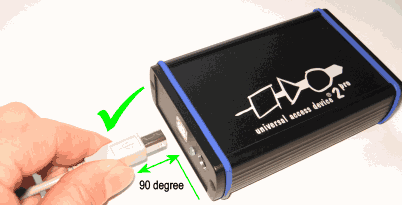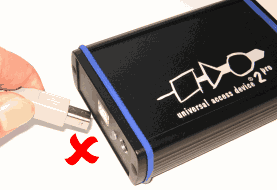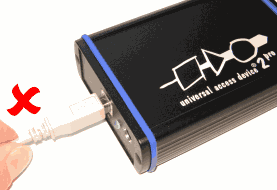UDE Hardware FAQs
UDE Hardware Frequently Asked Questions (Toggle all items)
How can I prevent the USB port of a UAD from being damaged?
Mechanical Safety Instructions
Hold the head of the USB cable with your index finger and thumb on both sides and insert the cable straight into the USB port as shown in the illustration below. Make sure that you insert it straight and not at an angle.
Hold both sides of the USB cable with your index finger and thumb at the point where it is connected to the computer and carefully pull it out horizontally to remove the cable from the USB port.
Do not insert or remove a USB plug with excessive force.
Do not plug in or pull out the USB plug upwards, downwards, left, right or forwards.
Do not pull or tug on the USB cable when plugged into the port.
⚠ Please see the "UDE Quick Reference Guide.pdf" and the "UDE Manual.pdf" for further information ⚠
Do I have to attend the electrostatic loading and ground potential differences ?
Yes. Electrostatic Discharge (ESD) can damage a sensitive electronic component ...
Under several conditions static electricity and ground potential differences between the Access Device and the user's target hardware can build up high voltages - over 10000 Volts (10 kV) in some cases. The electrostatic discharge of this build-up voltage results in fast high current waveforms and fast magnetic (H-field) or electrostatic (E-field) disturbances.
The discharge into the electronic components and circuitry can damage or destroy hardware components, resulting in failures and reduced reliability. Because of the non-hot-pluggable 3.3 Volts / 5 Volts - TTL properties of the JTAG and the 3Pin/Serial connectors, these ports are endangered especially. The maximum voltage on these pins may not exceeded 5.5 Volts against the UADs ground, especially in the case that the ground planes are not connected first.
To protect your hardware against damage from static electricity and ground potential discharge, you must follow some basic precautions:
- Before you change any cable connections from the Access Device, please remove the power from the Access Device and your target system.
- Please ensure that the static electricity and ground potentials between the Access Device, the host PC and the target hardware are balanced. If there is a danger of high potential differences, you must connect the Access Device, the host PC and the target hardware to the same ground domain via a low resistance connection.
- Establish the target connection and power on the systems.
In all cases, the following rule must be attended:
The first connection between the devices must be done via the ground !
Solution
All Universal Access Devices are equipped with a ground socket on the front side. Please use this ground socket for discharging the static electricity and balancing ground potentials between the Universal Access Device, the host PC and the target hardware BEFORE you connect the target hardware to the Access Device.
An additional protection for UAD can be achieved by using the JTAG Protector. In hard process environments it is strongly recommended to use the UAD-JTAG-Protector. The UAD2pro, UAD2+ and UAD3+ contain the protection function already. Please note, that the JTAG Protector DOES NOT suspend the precautions described above.
⚠ Please see the "UDE Quick Reference Guide.pdf" and the "UDE Manual.pdf" for further information ⚠
How can I connect to my UAD in a VMware 9 machine running on Windows?
I always get an error message "The connection to the USB device .... was unsuccessful (Driver Error)..." After installing / updating my VMware package to version "9", I'am unable to connect to my UAD inside the VM. How can this be solved?
Because of an VMware Bug the driver of the UAD, connected to an USB port, can not be installed. Please perform the following workaround to solve this issue:
- Disconnect the UAD from your VMware environment (if possible)
- Deinstall your current UDE 4.x Version
- Download and Install the latest UDE Version >= v4.00.07 (Build 2541)
- Do an UAD firmware upgrade
4.1 Start UDE, load a workspace and connect to a target
4.2 The firmware procedure will start immediately upon target connection attempt
4.3 DO NOT POWER OFF THE UAD during the firmware upgrade process!!
4.4 After successful upgrade terminate the UDE - Prepare the UAD for VMware
5.1 Open a command prompt (Start --> Run --> "cmd.exe" <Enter>")
5.2 "cd" to you UDE installation directory (e.g. "cd \Program Files (x86)\pls\UDE 4.00.07")
5.3 Enter "CommDevTest /t UAD2 /s <your serialnumber> VMwareBug" (without "<" and ">")
5.4 Agree with "y" to install the bugfix (without "")
5.5 Select the new marker character (default is 1)
5.6 Follow further displayed instructions to complete
After preparing and und repower the UAD, you should be able to connect to VMware and the driver should be installed automatically.
For further questions please contact: support@pls-mc.com
The communication to the target goes down often. The UAD is used via USB interface.
The USB communication seems to be instable. The UAD is specified to use the USB 2.0 High-Speed-Mode (480MBit/s). No-Name cables with USB 2.0 marking, but with length over 3m or small diameter under 5 mm are not suitable and result in communication aborts. The USB cables delivered within the UAD package are verified for compatibility with USB 2.0 High-Speed-Mode. Please only use these USB cables!
The same problem can occur while using USB ports located on the front of the PC case, which are extended with improper adapters. Please only use USB ports located directly on the IO panel of the mainboard!
Within UDE I can't select my network attached UAD, but a direct connection using the IP address is ok.
This behavior may occur if the Universal Debug Engine (UDE) has not received the identification broadcast from the network connected UAD2+ or UAD3+.
Background: Under normal circumstances, all available network UADs are listed by Universal Debug Engine (UDE). To create the list and identify the devices, a broadcast will be send. This broadcast (or the answer from UAD) might be blocked ... The UAD2+ / UAD3+ can still be used for debugging, because there is a TCP connection used.
The problem occurs for instance, if you use a separated network card for the UAD. Windows 7 will declare the "Unknown Network" as Public (high security firewall settings).
Solution: Broadcasts are usually blocked by a router. If the UAD is connected behind a router you might connect the UAD to the same network as the host PC (e.g. using a switch). If the communication is blocked by a firewall you can add an exception for UDE.
Windows 7:
- If UDE is started the first time, a firewall box will pop up. Select the appropriate network type to create the exception.
- To change this setting:
- Open firewall options Start - Search - Windows Firewall
- Select Advanced Settings (Left Side)
- Modify the Inbound Rule for UDE Desktop, UDE Visual Platform and (in case of UAD3+) UDE Access Device Configurator: Double-click for Properties and change the Advanced Settings to match the network type (e.g. allow Public)
My UAD2+ or UAD3+ doesn't work if it is connected over Ethernet.
If there are several connection losts or unexpected behavior, please check the following points...
- There may be a loader update required, if:
- The connection seems to be ok, but only after usage of an old UDE version.
- If you power off/on the Access Device, you can't connect to a target.
- In both cases you should see a message in command view:
ERROR: UAD2CommDev: Firmware update required !--> Please follow the steps mentioned under the topic "Update access device loader" in the UDE Message FAQs. - Are the Ethernet settings ok?
- Check settings in windows device manager (Properties of "Universal Access Device x", Tab: Hardware), connect the Access Device via USB or FireWire to do so.
- You can also change the settings per web browser, if you know the IP of the Access Device: "http://IP.OF.Acess.Device".
- If the connection seems to be down for some seconds, please check the points mentioned under the topic "UAD via Network connection down for some seconds".
- The connection can be interrupted, because another UDE instance is using the same Target and Access Device. (Maybe from another PC?)
- Please use the latest UDE version (>3.0), there are improvements regarding connection issues.
- If you still have problems, please contact our support team.
When connected to UAD2+ or UAD3 via network the connection seems to be down for some seconds.
This occurs even when the access device is directly connected to the host PC. What could be the reason?
- The effect could occur if a connection to a local network is established and the second network adapter for the access device is configured for local routing. Periodically broadcast bursts from network components could overflow the access devices firmware and that's why sometimes TCP packets are lost. To solve the problem do not enabled local TCP/IP forwarding.
- The effect could occur when an running antivirus scanner periodically pulls down Windows's network stack. To solve that problem temporary disable the antivirus software.
While launching the Universal Debug Engine (UDE), the connection to the target system cannot be established.
General mistakes ...
- wrong interface cable used
- wrong Universal Access Device connector used
ASC bootstrap loader Monitor Interface:
- Possible Reasons for Communication Errors
- power supply fails
- ASC bootstrap loader mode in the target system not selected (if applicable)
- target not in RESET/Bootstrap loader mode
- wrong target configuration file used when launching UDE
- no external RAM for the monitor available
- no external RAM for the interrupt vector table available (0x0000 to 0x01FF)
- selected baud rate overruns external hardware
- Additional Diagnosis:
- Using the MiniMonitor Interface the diagnosis capabilities of the debugger are made available if external RAM access does not work at all.
ROM Monitor Interface:
- Possible Reasons for Communication Errors
- power supply fails
- bootstrap loader mode is selected
- wrong target configuration file used when launching UDE
- ROM content not correctly programmed
- no external RAM in the monitor data area available
- selected baud rate overruns external hardware
While launching the Universal Debug Engine (UDE), the connection to the Universal Access Device (UAD) cannot be established.
Reasons can be ...
- power supply fails
- wrong or missing communication cable to the host ( USB, IEEE1394 or Ethernet)
- Universal Access Device not running ( the green LED behind is not blinking)
- wrong driver installation
How can I determine the serial numbers of the used communication devices?
Serial number of Universal Access Device ...
- See the sticker at the bottom of the UAD2, UAD3 or
- Disconnect any target, power on the UAD/UAD2 and open a Workspace with a target configuration using the UAD/UAD2
- when connection fails, push the "View" button or open the __connection_failed_report*.txt file
- scroll down to
- Communication device:
Type/Revision: UAD, HW-Revision:
Serial Number: XXXXXX.
- Communication device:



